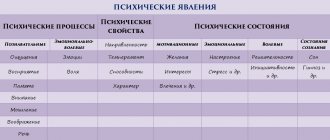General psychology test on the topic: Temperament and character
1 Which theories of temperament does W. Sheldon’s theory relate to?
humoral + constitutional behavioral neurodynamic
2 Accentuations are natural options for character development that are not typical: increased vulnerability, decreased ability to socially adapt + increased ability to socially adapt, disruption of the motivational sphere with the dominance of ambivalent states
3. Not a high level of mental activity, slowness of movements, easy fatigue, high emotional sensitivity is characteristic of: sanguine, choleric, phlegmatic + melancholic
4. Personality traits: modesty, self-criticism, selfishness, characterize the individual’s attitude: to other people to activity + to oneself to social and personal responsibility
5. Strong, balanced and mobile type of nervous system behind P.I. Pavlov is typical for: phlegmatic + sanguine choleric melancholic
6. For the first time, a psychological description of “portraits” of various temperaments was given by: Aristotle + Hippocrates I. Kant Plato
7. Strong, unbalanced type of nervous system behind P.I. Pavlov is typical for: + choleric sanguine sanguine phlegmatic melancholic
8. The ability to set goals, act on one’s own initiative and find ways to solve them characterizes a person as: decisive + purposeful, persistent, independent
9. Kretschmer said that isolation, emotional vulnerability, and rapid fatigue are typical for: +asthenics, picnics, athletes, dysplastics
10. The concept of extraversion and introversion was developed by: 3. Freud + K. Young A. Adler C. Rogers
11. The type of temperament that is characterized by slight vulnerability, a tendency to deep experiences, is typical for: + melancholic, choleric, sanguine, phlegmatic
12. Concepts such as: self-criticism, modesty, pride characterize: the attitude of others the individual’s attitude to things + the system of a person’s relationship to himself; features of the course of activity
13. The type of temperament that is distinguished by mobility, sociability and responsiveness is typical for: choleric + sanguine choleric phlegmatic melancholic
14. According to E. Kretschmer, aggressiveness and lust for power characterize; picnic dysplasticity asthenics + athletics
15. Accuracy, thrift and generosity are: traits that manifest themselves in relation to others + traits that characterize a person’s attitude to things; a system of a person’s relationship to himself; traits that manifest an attitude to activity
16. The formal-dynamic side of behavior is characterized by: + temperament orientation mood abilities
17Is it possible to change the type of temperament Yes + No It takes a lot of effort At an early age
18.NN. – a typical representative of the melancholic type of temperament. The formation of which of the character traits will require the least effort from him: determination + gullibility initiative impulsiveness
19. Stable individual personality traits that develop and manifest themselves in activity and communication are: abilities + character, temperament, inclinations
20. One of the authors of the constitutional theory of temperament: I.P. Pavlov + E. Kretschmer I.P. Pavlov J. Guilford L. Thurston.
21. A. is a representative of the sanguine type of temperament. Which character trait is easier to develop in him? + sociability, discipline, responsiveness, hard work
22. A sensitive reaction in response to the force of external influence is an indicator of: reactivity + sensitivity, activity, plasticity and rigidity
23 Natural basis of temperament: brain + type of nervous system dynamic stereotype nervous processes
24 Type of temperament, which is characterized by increased impressionability and touchiness: choleric, sanguine, phlegmatic + melancholic
25 Type of temperament, which is characterized by hot temper and haste in action: + choleric sanguine phlegmatic melancholic
26 What characterizes temperament: +quick involvement in work Politeness neatness hard work
27 What is the character trait for a melancholic temperament: reactivity and activity + emotional excitability, plasticity and rigidity, sensitivity and sensibility
28 The doctrine of the types of higher nervous activity as the physiological basis of temperament belongs to: + Pavlov Ilyin Hippocrates Ukhtomsky
29 A process opposite to excitation, which leads to a slowdown or delay in the conduction of impulses in the nerve centers: + inhibition dynamism melancholy lability
30 Character is + Stable personality traits that determine a person’s attitude towards people, towards himself, towards the work performed
A set of properties that characterize the dynamic features of the course of all mental processes and human behavior, their strength, speed, occurrence, cessation and change
Genetically determined phenomenon
Basic criteria for a psychological portrait of a personality - from temperament to self-esteem
The development of individuality continues throughout life. In management, we must remember that people adapt to life conditions differently. In individuality, basic and programming properties are distinguished. Let us briefly consider the main components that characterize the psychological portrait of a person.
Determining the psychological portrait of an individual is one of the most difficult and important issues, the solution of which will improve the success of personnel management. Let us present some provisions that define the psychological portrait of an individual, based on the basic idea of management psychology: treating a person poorly is unprofitable.
In managing people, we must remember that people adapt to life conditions in different ways. Based on their ability to adapt, three types of people can be distinguished:
- With an orientation to the current moment and easy adaptability to the situation.
- With a focus on the past, the ability to act within a rigid structure with clear permissions and prohibitions, rights and responsibilities.
- With a focus on the future, behavior inappropriate to the situation, poorly adapted to the hierarchical structure.
The first type of people works better when making decisions, the second - when implementing them within the framework of existing structures, the third - as generators of ideas.
It is important for every leader to be able to reveal their internal psychological reserves. To do this, you need to learn to know yourself and other people, identify temperament, character, personality orientation, attitude to activity and life, goals and life situations, expected emotional behavior in tense situations and interpersonal relationships, business qualities.
In individuality, basic and programming properties are distinguished. The basic ones include temperament, character, and human abilities. It is through the basic properties that the dynamic characteristics of the psyche are revealed (emotionality, rate of reactions, activity, plasticity, sensitivity) and a certain style of behavior and activity of the individual is formed. Basic properties are an alloy of innate and acquired personality traits in the process of education and socialization.
The main driving force for the development of individuality is its programming properties - direction, intelligence and self-awareness. Individuality has its own internal mental world, self-awareness and self-regulation of behavior, which develop and act as organizers of the behavior of the “I”.
Based on an assessment of a person’s properties, it is possible to create a psychological portrait of the person, which includes the following components:
- temperament;
- character;
- capabilities;
- direction;
- intelligence;
- emotionality;
- strong-willed qualities;
- ability to communicate;
- self-esteem;
- level of self-control;
- ability for group interaction.
The development of individuality continues throughout life. With age, only a person’s position changes - from an object of education in the family, school, university, he turns into a subject of education and must actively engage in self-education. Let us briefly consider the main components that characterize the psychological portrait of a person.
Temperament
Observing other people, how they work, study, communicate, experience joy and sorrow, we undoubtedly pay attention to the differences in their behavior. Some are fast, impetuous, mobile, prone to violent emotional reactions, others are slow, calm, imperturbable, with imperceptibly expressed feelings, etc. The reason for such differences lies in a person’s temperament, inherent in him from birth.
The founder of the doctrine of temperament is the ancient Greek physician Hippocrates (V-IV centuries BC), who believed that there are four main fluids in the human body: blood, mucus, bile and black bile. The names of temperaments, given by the names of liquids, have survived to this day: choleric , comes from the word “bile”, sanguine - from the word “blood”, phlegmatic - mucus and melancholic - black bile. Hippocrates explained the severity of a certain type of temperament in a particular person by the predominance of one or another liquid.
In modern psychology, the word “temperament” denotes the dynamic features of the human psyche, i.e. only the pace, rhythm, intensity of mental processes, but not their content. Therefore, temperament cannot be defined by the word “good” or “bad.”
Temperament is the biological foundation of our personality; it is based on the properties of the human nervous system and depends on the structure of the human body and metabolism in the body. Temperament traits are hereditary and therefore extremely difficult to change.
Temperament determines a person’s style of behavior and the methods a person uses to organize his activities. Therefore, when studying the traits of temperament, efforts should be directed not at changing them, but at understanding the characteristics of temperament in order to determine the type of human activity.
Temperament types:
A sanguine person is the owner of a strong type of nervous system (that is, nervous processes are strong and durable), balanced, mobile (excitation is easily replaced by inhibition and vice versa); Choleric is the owner of an unbalanced type of nervous system (with a predominance of excitation over inhibition); Phlegmatic - with a strong, balanced, but inert, immobile type of nervous system; Melancholic - with a weak, unbalanced type of nervous system.
You need to find your own approach to a representative of each type of temperament based on certain psychological principles:
1. “Trust, but verify.” This suits a sanguine person, who has the following advantages: cheerfulness, enthusiasm, responsiveness, sociability - and disadvantages: a tendency to arrogance, scatterbrain, frivolity, superficiality, over-sociability and unreliability. A nice sanguine person always promises so as not to offend another, but he does not always fulfill his promise, so you need to check whether he has fulfilled his promise.
2. “Not a moment of peace.” This is the principle of the approach to a choleric person. The principle is based on the use of its advantages: energy, enthusiasm, passion, mobility, determination - and the neutralization of its disadvantages: hot temper, aggressiveness, lack of self-control, intolerance, conflict. A choleric person must be busy all the time, otherwise he will direct his activity towards the team and can corrupt it from the inside.
3. “Don’t rush.” This should be the approach to a phlegmatic person who has the advantages: stability, constancy, activity, patience, self-control, reliability - and the disadvantages: slowness, indifference, “thick skin,” dryness. The main thing is that a phlegmatic person cannot work under time pressure, he needs an individual pace, so there is no need to rush him, he will calculate his own time and get the job done
4. “Do no harm.” This is the motto of a melancholic person, which has advantages: high sensitivity, gentleness, humanity, goodwill, the ability to sympathize - and, of course, disadvantages: low performance, suspiciousness, vulnerability, isolation, shyness. You shouldn’t shout at a melancholic person, put too much pressure on them, or give sharp and harsh instructions, as they are very sensitive to intonation and very vulnerable.
In fact, it is difficult to meet a person who fully corresponds to a certain type of temperament; one of them is dominant.
More on the blog: Using fluctuations in the science of influence
Purely formally, without taking into account the specifics of each individual, when organizing working pairs, one can proceed from the following principle: it is easiest for a choleric person to work with a sanguine person, for a sanguine person - with a melancholic person, and for a melancholic person - with a phlegmatic person.
If you are a sensitive melancholic person, then you are a wonderful friend; if you are a phlegmatic person, then your loved ones, friends and subordinates can hide behind you, “like behind a stone wall,” because you are very reliable; If you are a choleric person, then you can hope for the success of your life path, since you are good at setting goals and achieving them. Well, if you are sanguine, then warm sunlight emanates from you, which is also what people need in our lives.
Character
Character is a set of stable individual characteristics of a person that develop and manifest themselves in activity and communication, determining the typical modes of behavior for that person. Those personality traits that relate to character are called character traits.
Character traits are not random manifestations of personality, but stable features of human behavior, features that have become properties of the personality itself. Character expresses not random, but the most typical, essential features of a person.
In the character structure, there are 4 groups of traits that express the individual’s attitude towards a certain aspect of activity:
- to work (for example, hard work, a penchant for creativity, conscientiousness in work, responsibility, initiative, perseverance and the opposite traits - laziness, a tendency to routine work, irresponsibility, passivity);
- to other people, the team, society (for example, sociability, sensitivity, responsiveness, respect, collectivism and their opposites - isolation, callousness, callousness, rudeness, contempt, individualism);
- to oneself (for example, self-esteem, correctly understood pride and the associated self-criticism, modesty and their opposites - conceit, sometimes turning into vanity, arrogance, resentment, egocentrism, selfishness);
- to things (for example, neatness, thrift, generosity or, on the contrary, stinginess, etc.)
The core of the formed character is the moral and volitional qualities of the individual. A person with a strong will is distinguished by certainty of intentions and actions and greater independence. He is determined and persistent in achieving his goals.
Lack of will in a person is usually identified with weakness of character. Even with a wealth of knowledge and a variety of abilities, a weak-willed person cannot realize all his potential.
Karl Leonhard identified 4 types of character: demonstrative, pedantic, stuck, excitable.
Demonstrative type , which got its name because of the ability of people of this type to express their emotions very strongly, from the point of view of others - more strongly than they are experiencing them at the moment. A demonstrative personality has a developed ability to repress some traumatic ideas from consciousness: she can lie without realizing that she is lying, while the lies of a demonstrative personality differ from the conscious lies of a pretending person.
She is not pretending, but really at the moment believes in what she is trying to convince others of. A demonstrative personality deeply adapts to the image required by the situation, and is characterized by high artistry in expressing any feeling: grief, admiration, etc.
The favorite images into which a demonstrative personality is reincarnated are an innocent victim, a person who was not appreciated, his trust was abused, his rare spiritual and intellectual qualities were used, etc., or a benefactor of humanity, a unique specialist, a gentle, subtle creature in need of tireless care .
With positive social development, a demonstrative personality can become an excellent writer, actor, social worker - thanks to the ability to get used to another image, to understand another person.
The opposite of demonstrative is pedantic . If a demonstrative person makes decisions quickly, impulsively, the thinking process is reduced to a minimum, then a pedantic person hesitates for a long time and carefully thinks about his actions.
Negative traits of this nature may be indecision, fear of an accident or mistake, which makes it necessary to constantly check and double-check your actions whether the gas is turned off, whether there is an error in the report, whether your hands are dirty, etc., unless, of course, these are isolated cases, and sustainable behavior.
But, as you know, our virtues are a continuation of our shortcomings, and a pedantic character can be expressed in such excellent qualities as punctuality, accuracy, responsibility, forethought, prudence, concern for one’s own health, avoidance of excesses - in a word, the whole complex that a demonstrative personality clearly lacks lacks.
The next type of character is stuck. People of this type are characterized by a very long delay in strong feelings (affects) of rage, anger, fear, especially when they were not expressed in real life due to some external circumstances. This affect may not fade and flare up with its original brightness after weeks, months, even years.
A stuck person experiences his successes just as long and vividly. People of this type are distinguished by touchiness and vindictiveness. The most common “ideas” and themes of stuckness are: jealousy, persecution, revenge. These people can say about themselves: “I can forgive an insult, but not forget it.”
Excitable individuals, just like demonstrative and stuck ones, often have a very uneven course of life, but not because they constantly avoid difficulties, but because they often express dissatisfaction, show irritability and a tendency to impulsive actions, without bothering to weigh the consequences . The inability to manage oneself leads to conflicts.
Capabilities
Ability in psychology is considered as a special property of a psychological functional system, expressed in a certain level of its productivity. Quantitative parameters of system productivity: accuracy, reliability (stability), speed of operation. Abilities are measured by solving problems of a certain level of difficulty, resolving situations, etc.
The level of abilities is determined by the degree of resolution of contradictions between the properties of an individual and the relationships of the individual. The best option is when you have abilities in any field of activity and an interest in doing it.
Abilities are divided into general and special. General abilities can predetermine a tendency to a fairly wide range of activities; they are formed by the development of intelligence and personality traits.
General abilities include:
- readiness to work, the need to work, diligence and high efficiency;
- character traits - attentiveness, composure, focus, observation;
- development of creative thinking, mental flexibility, ability to navigate in difficult situations, adaptability, high productivity of mental activity.
More on the blog: Psychology and philosophy are relatives
General ability acts as a socio-psychological basis for the development of special abilities for a certain type of activity: musical, research, teaching, etc.
Personality orientation
The basis of a person’s orientation is the motivation of his activities, behavior, and satisfaction of needs. Focus can be on the task, on communication, on oneself. One person can satisfy only physiological needs and ensure the security of existence.
For others, in addition to these needs, it is very important to satisfy social needs and the needs for self-expression and the realization of creative abilities. The task of the manager and psychologist is to identify the needs, interests, beliefs of each individual and determine the specific direction of his motives.
Intelligence
Soviet psychologist S.L. Rubinstein considered intelligence as a type of human behavior - “smart behavior”. The core of intelligence is a person’s ability to identify essential properties in a situation and bring his behavior into line with them. Intelligence is a system of mental processes that ensure the implementation of a person’s ability to assess a situation, make a decision and regulate his behavior in accordance with this.
Intelligence is especially important in non-standard situations - as a symbol of a person’s learning everything new.
The French psychologist Jean Piaget considered one of the most important functions of intelligence to be interaction with the environment through adaptation to it, that is, the ability to navigate conditions and structure one’s behavior accordingly.
Adaptation can be of two types: assimilation - adapting a situation through changing conditions to a person, his individual style of mental activity, and accommodation - adapting a person to a changing situation through a restructuring of his thinking style.
Intelligence can also be defined as the general ability to act expediently, think rationally, and function effectively in the environment (Wechsler).
The structure of intelligence depends on a number of factors: age, level of education, specifics of professional activity and individual characteristics.
In addition to cognitive intelligence, there is professional and social intelligence (the ability to solve problems of interpersonal relationships, find a rational way out of the current situation). It should be remembered that intelligence is cognition plus action. Therefore, it is necessary not only to develop all types of intelligence, but also to be able to implement rational decisions, show your intelligence both in words and in deeds, since only the result, specific actions determine the level of intelligence of an individual.
Emotionality
Since the time of Plato, all mental life has been divided into three relatively independent entities: mind, will and feelings, or emotions.
The mind and will are to some extent subordinate to us, but emotions always arise and act independently of our will and desire. They reflect the personal significance and assessment of external and internal situations for a person’s life in the form of experiences. This is the subjectivity and involuntary nature of emotions.
The ability to manage emotions most often means the ability to hide them. It’s a shame, but pretends to be indifferent; it hurts, but it is hidden; It’s offensive, but outwardly there’s only irritation or anger. We may not show our emotions, but this does not weaken them, but more often they become even more painful or take on a defensive form of aggression.
Managing emotions is simply necessary, firstly, for health, and secondly, out of ambition. All emotional phenomena are divided into affects, emotions themselves, feelings, moods and stress states.
The most powerful emotional reaction is affect. It captures a person entirely and subjugates his thoughts and actions. Affect is always situational, intense and relatively short-lived. It occurs as a result of some strong (objective or subjective) shock.
Emotions themselves are a longer-term reaction that arises not only as a reaction to accomplished events, but mainly to anticipated or remembered ones. Emotions reflect an event in the form of a generalized subjective assessment.
Feelings are stable emotional states that have a clearly defined objective character. These are relationships to specific events or people (possibly imaginary).
Moods are long-lasting emotional states. This is the background against which all other mental processes take place. Mood reflects a general attitude of acceptance or non-acceptance of the world. The prevailing moods of a given person may be related to his temperament.
Stress is a nonspecific reaction of the body in response to an unexpected and stressful situation. This is a physiological reaction, which is expressed in the mobilization of the body's reserve capabilities. The reaction is called nonspecific, since it occurs in response to any adverse effect - cold, fatigue, pain, humiliation, etc.
Ability to communicate
Communication is an extremely subtle and delicate process of interaction between people. In communication, the individual characteristics of all participants in this process are revealed in the most diverse way. Communication has its own functions, means, types, types, channels, phases.
The most obvious function of communication is the transmission of some information, some content and meaning. This is the semantic (notional) side of communication. This transmission affects a person’s behavior, actions and deeds, the state and organization of his inner world. In general, we can distinguish informational (obtaining information), cognitive, control and developmental functions of communication, the function of exchanging emotional and generally mental states.
Means of communication can be verbal (speech in different forms) and non-verbal (pantomime, facial expressions, gestures, etc.)
Types of communication: communication between two (dialogue), communication in a small group, in a large group, with the masses, anonymous communication, intergroup communication. The listed types relate to direct communication.
Communication channels: visual, auditory, tactile (touch), somatosensory (feelings of your body).
Types of communication: functional-role (boss - subordinate, teacher - student, seller - buyer), interpersonal, business, rapport (communication with one-sided trust - the patient trusts).
Phases of communication: planning, making contact, concentrating, motivational sounding, maintaining attention, argumentation, recording the result, completing communication.
Self-esteem
Based on self-knowledge, a person develops a certain emotional and value-based attitude towards himself, which is expressed in self-esteem. Self-esteem involves assessing your abilities, psychological qualities and actions, your life goals and opportunities to achieve them, as well as your place among other people.
Self-esteem can be underestimated, overestimated and adequate (normal).
Author: Rais Akhmetovich Fatkhutdinov, Doctor of Economics, Professor of RAGS and Russian State University of Innovative Technologies and Entrepreneurship.
Source
Read us in a convenient Telegram | Facebook | Instagram | Tags
9.1. Temperament
tags:
Property, Temperament, Rigidity, Express, Education, Existence, Difference, Psychological Topic. Temperament.
- Levels of mental regulation of behavior. The concept of temperament, the main problems of its study.
- Development of the doctrine of temperament. Psychological characteristics of T: properties and types of temperament.
- Signs of temperament.
- Functions of temperament.
Concepts: individuality, temperament, ergicity, plasticity, pace, emotional sensitivity.
The structure of a person’s individuality integrates properties of different levels: natural and social. Individuality is a biosocial characteristic of a person, an alloy of natural and social. It is formed in the process of complex interaction between the heredity of an individual and the environment of his life. The dynamic side of regulation is provided by temperament, the content side is provided by character, productivity and efficiency - abilities. The properties of temperament in the structure of individual properties are the individual properties of a person that determine the dynamics of Ψ activity.
1. Temperament is a naturally determined side of a person’s individuality, closely related to his constitution (morphological, biochemical, physiological
x-mi, which form the basis and mechanism of T).
T, in turn, is the prerequisite and basis of personal formations - X. T is the earliest in origin, simple in structure formal-dynamic characteristic of individuality. T is the most studied category in Ψ individual differences.
The main problems of studying T:
- revealing the biological basis of T;
- search and measurement of Ψ components of T, i.e. its properties;
- establishing the place of T in the structure of individuality (the role of T in the development of X and general C);
- study of T as a factor in the success of professional D (sports, academic).
2. A.R. Luria expressed a paradox. The greatness of a scientist is determined by the extent to which the ideas he put forward delayed the development of scientific thought (J. Piaget).
8 pages, 3956 words
Types of human temperament
... capabilities (do not confuse temperament properties with character properties or abilities). The following main components that determine temperament can be distinguished: . The general activity of a person’s mental activity and behavior is expressed to varying degrees...
The idea that there are T types associated with an organism, or the idea that individual differences are biologically determined (T is the biologically determined aspect of individuality).
For the first time, the idea of the existence of psychological types associated with the characteristics of the body was expressed by Hippocrates. Humoral (fluid) concept: T depends on the ratio of the 4 body fluids (krasis - ratio of parts).
Which ones?
Blood-sanguis
Phlegma - lymph
Chole - bile
Melana chole - black bile.
In the 18th century I. Kant - Ψ portraits - a phenomenological characteristic of types, which has become the property of everyday consciousness.
From Hippocrates - the idea of the existence of types related to the characteristics of the organism ( typology
).
At the beginning of the 20th century. Constitutional theories.
E. Kretschmer – body structure features, type
body type – T type:
Asthenic – withdrawn, emotionally vulnerable, gets tired quickly.
Picnic - talkative, sociable...
The athlete is aggressive, power-hungry, expansive.
W. Sheldon - assessed the physique by the development of 3 main tissues: ectomorphs (skin, hair); endomorphs (internal organs); mesomorphs (musculoskeletal system).
The actual scientific fate of the doctrine of T began with the teaching of I.P. Pavlov, who connected 4 types of temperament with the properties of the NS.
Scientific Ψ study proceeds along 2 lines: physiological and Ψ.
I.P. Pavlov 3 properties of the NS: strength, balance, mobility form the NS type (4)
| strong | weak | ||
| balanced | Unbalanced | ||
| mobile | inert | ||
| sanguine | phlegmatic person | choleric | melancholic |
Further research at the school of B.M. Teplov and V.D. Nebylitsyn. A new approach to the study of the properties of the NS is “the general properties of the NS: activity and emotionality.
Western psychologists are not general (functional) psychologists, but “private” ones - i.e. properties of individual morphofunctional formations of the brain. Example: G. Eysenck – activation in the limbic system corresponds to “neuroticism”.
The modern trend in the search for organic bases of T: going beyond the central nervous system into morphology. Activity of endocrine systems..., i.e. within the broader boundaries of human biological functions, because The NS does not exist outside the body.
The psychological line of the doctrine of T originates from I. Kant.
- Psychological characteristics of T involve identifying its properties and types.
V.S. Merlin identified the following properties of temperament: sensitivity, reactivity and activity, rate of reactions, plasticity and rigidity, extroversion and introversion, emotional excitability.
Types of temperament are characterized by a combination of properties. A sanguine person, a choleric person, and a phlegmatic person are based on the strength of the NS, while a choleric person is based on weakness. G. Eysenck describes T types as a combination of 2 properties: extraversion and neuroticism.
Currently, 4 types of T no longer appear anywhere (neither in Ψ nor in physiological terms).
There are “dynamic aspects” of behavior: activity and emotionality. T (in the Ψ sense) is a set of corresponding dynamic properties of behavior, uniquely combined in each individual.
V.M. Rusalov identified 4 fundamental saints of T, linking them to 4 blocks of the functional system (P.K. Anokhin).
4 blocks of information storage and processing: afferent synthesis block
Programming (decision making)
Performances
Feedback.
Saints T: 1) ergicity - the degree of tension between the body and the environment (activity, tension, thirst for activity; sociability, desire for leadership - relaxation, passivity; social passivity, isolation).
2) plasticity - ease of switching from one behavior to another (ease of switching, flexibility - rigidity, conservatism, monotony).
3) tempo - the speed of execution of the behavior program (speaks quickly - speaks slowly).
4) emotional sensitivity - sensitivity to the discrepancy between what is and what should be (calmness, confidence, insensitivity to failures; assessments - uncertainty, worry, anxiety, sensitivity to failures in work; communication. Sensibility, vulnerability.
OST test – T structure questionnaire.
- Signs of temperament properties.
What do the selected properties have in common?
Dynamism, stability, “ontogenetic” primacy, statistical frequency, extremeness, conditionality by the properties of the NS, independence from the content, motive and purpose of behavior (style aspect of behavior); universality of manifestation in all types of D.
- Functions of temperament.
— adaptive role: regulates a person’s expenditure of his energy-dynamic capabilities, protecting the body from overload.
— energetic: the properties of temperament are in a relationship of complementarity and compensation.
In general, it regulates the dynamics of mental activity, which ensures the optimal functioning of the individual and the preservation of the basic vital constants of the body.
Literature.
Workshop on general psychology. /Ed. A.I. Shcherbakova. – M., 1990. P.231-246. (solving Ψ problems).
Psychology of individual differences / ed. Yu.B. Gippenreiter, V.A. Romanova. – M., 2000.
Contemporary psychology: A reference guide. – M.: INFRA-M, 1999. – P.439-453.
Examples of similar educational works
Signs of a person’s individuality:
... aspects of activity. Temperament is the basis of character development. From a physiological point of view, it is determined by the type of higher nervous activity of a person. General and specific properties: a general dynamic picture of human behavior in the greatest...
The concept of temperament and its types
...approach to the study of man. A person is considered both from the perspective of his inherent universal human properties and from the perspective of his unique individuality. And individuality is manifested in the traits of temperament, character, habits, prevailing...
Select the phase of aggressive behavior in which the person is ready to discuss the incident
… 4) individuality TICKET No. 17 1. The formal-dynamic side of behavior is characterized by: 1) Direction 2) Temperament 3) Character 4) Abilities 2. The essence of projection is: 1) attributing one’s own to other people
The importance of professionalism for a person’s individuality
PROFESSIONALISM AND INDIVIDUALITY OF A HUMAN The unit of human behavior in society is an act, which, from the point of view of the final result, is aimed at affirming a value, and not at a pragmatic goal. A person's individuality is manifested in...
Moral standards and moral behavior in the relationship “person - society - ...
...considers man as an extremely plastic being, capable of various social adaptations. Psychology, in contrast to this attitude, seeks stable characteristics of the psyche that ensure the constancy of the individual’s behavior...
Behavior as a psychophysiological phenomenon
... by voluntarily suppressing the desire to satisfy a very strong need. There are two more types of behavior: normal and deviant behavior. Man is a social being, we live in a society that has clearly defined norms...









